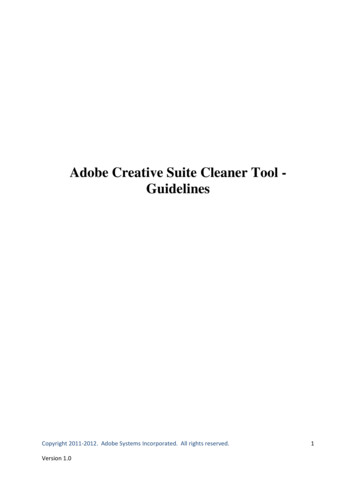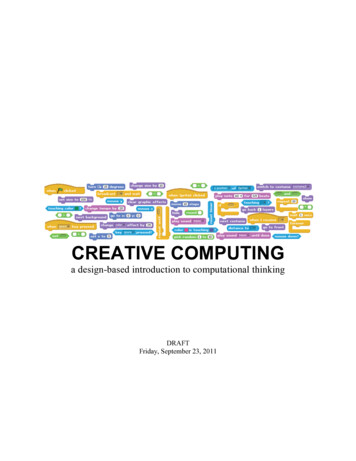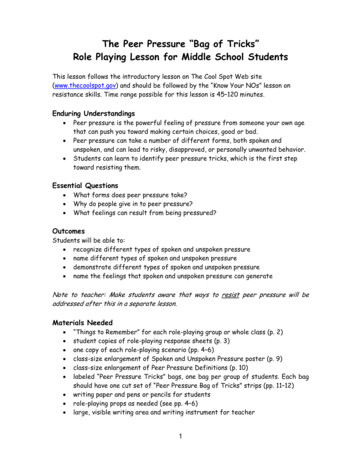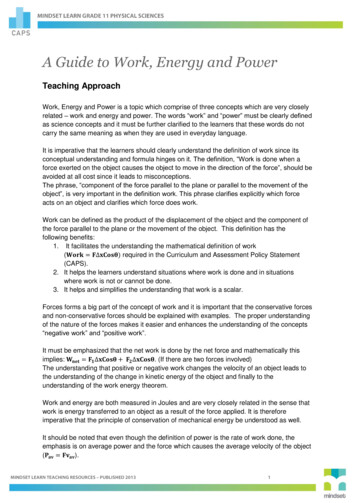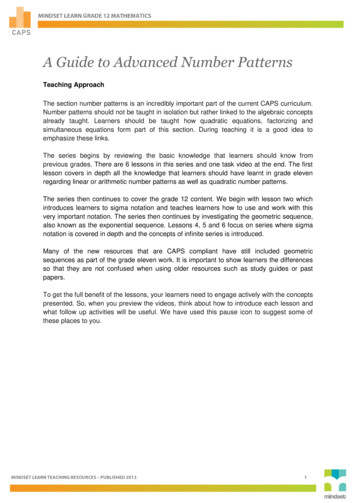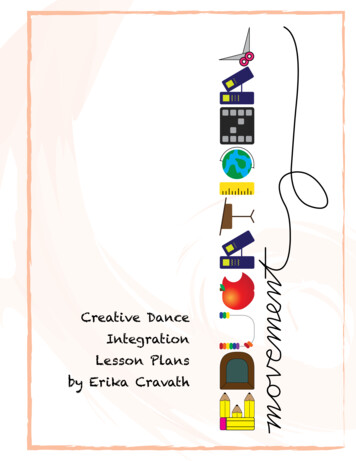
Transcription
Creative DanceIntegrationLesson Plansby Erika Cravath1
AcknowledgmentsSupport for this project was provided by:B e v e r l e y Tay l o r S o r e n s o nPartnershipArts Reaching & Teaching in Schools 2011 Erika CravathThis may be copied, distributed and posted for internet public accessfor personal, non-profit educational purposes.Any Commercial uses require the permission of the copyright owner.All curriculum standards were created by the Utah State Office ofEducation and are found at www.uen.org.To contact the author with questions or comments, emaileducationalmovement@gmail.comCover art by Zachary WoffindenLayout by Heidi Israelsen2I am sincerely grateful to the many peoplewho assisted me in this project, including:Marilyn Berrett, my mentorDeAnn Sanders, my other mentorAll my students, who made this packet possibleClayton Cravath, my supportive husband3
Table of ContentsAcknowledgments.3Introduction.7How to Use This Book.9Tips for Teaching Dance.10Other Ideas for Incorporating Dance into the Classroom.122nd Grade Lesson PlansMath: 2-Digit Addition with Regrouping. 14Math: Number Ordering. 16Math: Telling Time (A.M. vs. P.M.). 18Social Studies: Cultures Part I. 20Social Studies: Cultures Part II. 22Social Studies: Mapping. 24Music: Music and Rhythm. 26Music: Musical Canon. 28Language Arts: Row, Row, Row Your Boat. 30Languages Arts: Homophones. 32Language Arts: Prefixes un- and re-. 34Science: Animal Adaptation. 36Science: Winter Weather. 385th Grade Lesson PlansLanguage Arts: Essay Composition. 40Science: States of Matter. 42Science: Static Electricity. 46Visual Art: Illustration. 48Social Studies: The Charleston and Dance Culture in the 1920’s and 30’s. 50Math: Fractions. 52Language Arts: Reading Comprehension. 54Music: Musical Beats and Rhythm. 5645
IntroductionMost elementary school teachers would agree that they have too many demands and toolittle time. After spending half the day on literacy, then squeezing in math, science, and socialstudies, few minutes remain for arts instruction, recess, creativity, and community-building activities. However, a well-rounded education is vital for children, who must learn creative and criticalthinking skills. Children learn in many ways, yet schools often cater to visual and linguistic learners,and kinesthetic learners can be seen as trouble makers. Elementary school teachers are expectedto provide a well-rounded, enriching education to all types of learners, ensuring that basic curriculum standards and life skills are taught.This book provides a detailed description of my method of addressing the above problem:using dance to teach and supplement the required curriculum. Combining dance with other curriculum areas is a student-centered approach that helps kinesthetic learners to better understandrequired class material. A fifth-grade student and kinesthetic learner said to me, “Usually I don’tunderstand science, but when you put movement into learning, I really understood all of it.”Dance brings children a sense of novelty and anticipation. A second-grade teacher I worked withsaid, “My class literally cheers when they see ‘Dance’ on the schedule. My students absolutelylove to dance.” Through dance, children can experience music and art from different cultures, periods, and techniques, which promotes deeper understanding through experiential learning.Not only can dance be used as a tool to teach curriculum, but also to teach creativity andcritical thinking. Throughout the lessons in this book, students are given choices where they mustdecide how to solve a given creative movement problem. Students learn to make independentdecisions and to find confidence in their bodies. A fifth-grade student told me, “I loved when wegot to make up our own dances. I felt like a pro.” Although it does require a willingness from theteacher to try a new and different method of teaching, dance in the classroom has incredible benefits, and all you need is a little preparation and a lot of dancing bodies!67
How to Use This BookThis book is designed to give every elementary school teacher the tools he or she needs tobegin incorporating dance into every-day curriculum. On the next page, you will find teaching tipsthat are especially important when teaching dance. The subsequent lesson plans in this book werespecifically created for second and fifth grades, but could be adapted to fit younger or older gradesas needed.The lesson plans in this book are divided into sections based on lesson content: Reading,Math, Science, Social Studies, Music, and Visual Art. Each lesson is divided into four sections:Experience/Identify, Explore/Investigate, Create/Perform, and Connect/Analyze. These are calledthe “Four Universal Principles of Learning,” and are the result of extensive research in the learningprocess by Marilyn Berrett. Use these lesson plans to incorporate dance into your own classroom,and feel free to adapt them as needed. Following the lesson plans is a list of other topics and ideasto incorporate dance into each curricular area. Try to create your own dancing lesson plans usingthe lesson plans and ideas in this book as a guide.Two years ago, I worked with a fifth-grade teacher who was terrified of dance and everything that related to dance. She did not know how to start using dance in the classroom. However, after team teaching a few lessons with me, she was ready to teach dance on her own. Shelater wrote, “As a grade level we rotate and teach the other classes our science lessons. I have enjoyed incorporating some of the things Erika taught my class. It has helped me to become a betterteacher.” My goal for this book is to help you to become a more diverse, student-centered teacher,helping students of all learning styles to learn.For a digital copy of additional visual aids (specified for each lesson if available), individuallesson plan, or a copy of the entire book, please visit http://education.byu.edu/arts. All materialscan be found under the Resrouces tab in Activities and Tools, in addition to other arts integratedlesson plans in all four art forms.89
Tips for Teaching DanceSay when before whatDescribe when students will do something before describing what they will be doing. ForLive in the momentWhen teaching a dance class, I sometimes forget to pay attention to what is going onaround me because I am so focused on what activity is coming next. Instead, live in the momentwith the students. Try to experience what they are experiencing and help them find new ways toexplore and discover. As in all teaching, if you are aware of your students needs, you will be betterable to teach them.example, when the music starts, skip to a new place in the room and freeze in a curved shape.Other cues may include: when I say go, when I count to three, when your partner freezes, when Ipoint to this picture, etc.Dance with the studentsWhenever I move with the students, their commitment to the movement increases. InsteadAllow a little chaosof giving instruction then watching the students complete the task, participate with them. MoveAs I have taught lessons where student creativity is central to the class, I have watched several teachers become worried that their students are incorrectly interpreting the creative prompts.throughout the classroom instead of always standing in the front. Students often do not need ademonstration; they just want the teacher to participate.However, every student should have his or her own ideas to express during the creative process.When twenty-five different ideas are being expressed, it can feel a little chaotic. The creative pro-Be clear and concisecess is not the same for everyone, so let there be a little chaos!As I explain activities, sometimes I find myself taking too much time in explanation and an-Challenge studentsElementary school students often surprise me with their dancing abilities. Just as in everyswering several questions before the activity starts. Instead, explain the activity as simply as possible. While students are moving, add on extra layers of difficulty or additional movement problems.Giving direction while the students are moving saves time and maintains student engagement.subject, we must expect the best from students. Therefore, it is important to constantly challengestudents to improve what they are doing. Ask questions like: Can you make your dance bigger?Can you show your movement more clearly? How can you make that movement more creative?Constantly add other elements of danceThough a dance lesson may focus on creation of shapes, challenge students to use differentMake rules for dance and remind studentsof them every time they come to danceI have often found that when students come to a dance class, they believe that all the rulesof their classroom no longer apply. It is important to establish rules at the beginning of each class.Helpful rules can include: stay one foot away from all furniture and walls; when we dance webody parts, energy qualities, levels, pathways, or timing. For example, shake your elbow while youspeak with our bodies, not our mouths; when the music stops, you stop; do not run into each other;skip. Now, turn your leap. Move in a curved pathway as quickly as you can. Perform the sequenceetc.as slowly as you can. Continue to add more layers on to an activity once they master its basicform.1011
Other Ideas for IncorporatingDance into the ClassroomLiteracyMake shapes based on prepositionsWrite a poem then create a dance to perform as it is readCreate a dance based on the characteristics of a book characterRecreate scenes from a novel or short story in a danceAssign movements to each part of speech (noun, verb, adjective, etc.) and create movementScienceUse energy qualities in dance to explore the water cycleIdentify how the five senses affect dance and try to dance with eyes closed or with earscoveredCreate the solar system using students instead of planets and replicate the movements ofthe planetsExplore how using different amounts of force affects dancingLearn bones, muscle groups, or organ systems through a body part dance; explore how eachbody part can move.“sentences”Write acrostic poems then use them to create a series of partner shapesMathAdd and subtract movements from a dance sequenceDivide the class in half for a movement problem, then thirds, quarters, etc.Repeat patterns in movement sequences and have students identify themCreate two- and three-dimensional shapes with the bodyExplain division of beats in music in terms of fractionsSocial StudiesLearn to respect differences through watching peer-created dances and giving positivefeedbackShare dances from the students’ culturesLearn folk dances from countries around the worldPractice group work through group movement problems and composition assignmentsCreate a dance inspired by an event in history (i.e. major battle, political movement,12exploration, etc.)13
Creative Dance Lesson Plan IntegratingMath: 2-Digit Addition with RegroupingGrade: 2ndLength: 45 minutesWritten by: Erika CravathStudent Learning Outcome: The students will demonstrate an understanding of 2-digit addition and hownumbers are divided into ones, tens, and hundreds, by creating representative shapes and movement.Equipment Needed: Hand Drum; CD player; CD with creative dance music; Poster to write math facts on, asneeded; pictures of dancers making number shapes; The Human Alphabet by Pilobolus (optional).Utah Core – MathDomain: Operations and Algebraic ThinkingStandard 1: Use addition and subtraction within 100 to solve one- and two-step word problems involving situations of adding to, taking from, putting together, taking apart, and comparing, with unknowns in all positionsUtah Fine Arts Core – DanceStandard 2: The student will identify and demonstrate the movement elements in performing dance.Objective 2: Expand dance vocabulary with movement experiences in space.a. Create symmetrical and asymmetrical shapes with the body, then alternate one with the otherwhile changing levels and/or the direction the body is facing.Standard 3: The student will improvise, create, perform, and respond to movement solutions in the art form ofdance.Objective 1: Explore the process of making a dance.Objective 2: Create and discuss movement solutions derived from movement exploration.Standard 4: The student will understand and demonstrate dance in relation to its historical and cultural originsObjective 3: Make connections between dance and other disciplines.Behavioral Expectations: (3 minutes)We have two rules for class today:1. Always keep space around yourself. Never touch anyone else, the walls, or the steps unless I ask you to.2. When the music or the drumming stops, you must freeze!ground. Make a straight shape where only one body part touches the ground.Ones, Tens, and Hundreds Shapes: Randomly choose three students (by birthday in a certain month, color theyare wearing, likes to eat spinach, what they ate for breakfast, etc.) and ask them to make a curved shape. Haveentire class mimic each shape one at a time, then assign a number amount to each shape, either ones, tens, orhundreds. When I turn on the music, move in curved shapes throughout the space. Create new curved shapes.Change the shape you are moving in. When the music stops, freeze in one of our three numbers shapes. Wheneveryone freezes, practice adding the shapes together. Do this on a poster or the board as well as orally.Curved, Bent, and Straight Lands: Divide the room into three sections: Curved, Bent, and Straight. If possible,label each area with posters. When I turn on the music, begin to move. If you are in curved land, you may onlymove in curvy ways. If you are in bent land, you may only move in bent ways. If you are in straight land, youcan only move in straight ways. However, you can change the land you are in whenever you want to. When youmove from one land to another, you must change the way that you are moving. When the music stops, everyone freeze. Assign a number value to each land (ones, tens, or hundreds) and add up the students in the class.For example, five students in bent land (hundreds), twelve students in curved land (tens), and eight students instraight land (ones) would equal 628. Repeat with the class and practice adding up the class together.Explore/Investigate: (10 minutes)Number Shapes: Create a number shape with your body. The number has to be between 0 and 9. What numbers can you make? Make a different number shape. Everyone make a number 1. (Go through 0-9 together). Isthere more than one way you could make a number shape with your body? Show pictures of Pilobolus or otherdancers creating number shapes with their bodies. What if I made a number with a partner? Then how would itlook? Demonstrate with a student how two people can work together to make one number shape. By the timeI count to three, be standing elbow to elbow with a partner. Together with your partner, create a number shapethat uses both of your bodies.Create/Perform: (12 minutes)Shape Trios: Divide students into groups of three. Each person will create a number with their body, and the triowill decide how to order those numbers into a 3-digit number. This number is their starting and ending shape.Once the music starts, students will move from their beginning shape in a curving way to a new place in theroom, then end in their ending 3-digit number shape. Once they have all practiced, have two trios perform atone time while the rest of the class observes. At the end of each trio, practice adding the two groups’ numbers.Ask students to identify any numbers they saw during the performance.Connect/Analyze: (5 minutes)Look at the math problems you have completed together as a class. What would happen if instead of regroupingthe ones in the tens column, you left them all at the end of the number (e.g. 37 25 512)? Then all the numberswould shift to the next higher grouping. What if we forget to carry a group of ten ones and do not add them tothe tens column (e.g. 46 18 54)? Then we miss a whole group of tens?Let’s practice. When the music starts, slide around the room, but when it stops you must freeze! Don’t move evenone eyelash!Experience/Identify: (15 minutes)Straight, Bent, and Curved shapes: Introduce three dance vocabulary words to students about shapes: straight,bent, and curved. Practice each shape with students. Challenge them to make new shapes: Make a straightshape in a low level. Make a curved shape with three curves. Make a bent shape in a high level. Make a curvedshape with your head lower than your feet. Make a bent shape where three bodies parts are touching the1415
Creative Dance Lesson Plan IntegratingMath: Number OrderingGrade: 2ndLength: 45 minutesWritten by: Erika CravathStudent Learning Outcome: The students will demonstrate understanding of number ordering throughpartner games and a group shape creation using levels in dance to identify if a number is less than, equalto, or greater than ten.Equipment Needed: Hand Drum; CD player; creative dance music; symbol posters; number cards.Utah Core – MathDomain: Number and Operations in Base TenStandard 4: Compare two three-digit numbers based on meanings of the hundreds, tens, and ones digit, using , and sym boles to record the results of comparisons.Utah Fine Arts Core – DanceStandard 2: The student will identify and demonstrate the movement elements in performing dance.Objective 2: Expand dance vocabulary with movement experiences in space.Standard 3: The student will improvise, create, perform, and respond to movement solutions in the art form ofdance.Objective 1: Explore the process of making a dance.Objective 2: Create and discuss movement solutions derived from movement exploration.Standard 4: The student will understand and demonstrate dance in relation to its historical and cultural originsObjective 3: Make connections between dance and other disciplines.Behavioral Expectations: (3 minutes)We have two rules for class today:1. Always keep space around yourself. Never touch anyone else, the walls, or the steps unless I ask you to.2. When the music or the drumming stops, you must freeze!Let’s practice. When the music starts, gallop around the room, but when it stops you must freeze! Don’t move evenone eyelash!Experience/Identify: (10 minutes)Discussion: Today we are learning about three symbols. They are posted on the wall. These symbols are usedto show which number out of two numbers is bigger. You already know one symbol. Which one is that? Theequal sign! The next symbol is the greater than symbol. It is used when the first number is bigger and the secondnumber is smaller. You always point the open side toward the bigger number. When I see the greater than symbol, I like to think of a mouth. If the symbol is a wide-open, hungry mouth, then it will want to eat as much as16possible. That’s how you know to point it toward the bigger number. The other symbol is the less than symbol.It is just the greater than symbol backwards. You use this one when the first number is smaller and the secondnumber is bigger.Making Group Shapes: I need six volunteers. Divide students into one group of three, one group of two, and oneindividual student. Students in groups will make a connecting shape, while the individual student makes a shapeby him or herself. Which shape is the biggest? Why? So could we say that the group of three is greater than(hold sign in between) the individual student? Is the individual less than the group of two?Let’s all try making connecting shapes. Make a shape with greater than two people. Make a shape with lessthan three people. Make a shape with equal to four people. Etc. Now, we will add different levels. Make a veryhigh shape with less than two people. Make a low shape with greater than three people.Explore/Investigate: (17 minutes)Level Exploration: When I hold up the greater than sign, move in a high level. When I hold up the equal to sign,move in a medium level, and when I hold up the less than sign, move in a low level. Try turning and jumping.Make interesting shapes while you move. Can you move lower?Number Cards: Give each student a number card numbered 1-10. Find a partner that has a number so thatyour number plus their number will equal 10. (Make sure you give the cards out so that each student will have apartner).Surprise Hand Game: Students will hold one hand behind their back, holding their fingers up in the number oftheir choice. On the count of three, students will show each other their hands. The person with the smallernumber (less than) makes a low shape. Students with the bigger number (greater than) make a high shape. Ifthe numbers are equal, their heads must be in the same level. Students should make their shapes as quickly aspossible.Shape Chain (If time permits): I need two line leaders. The line leader will dance through the space to this spot(mark a spot with tape, a piece of paper, etc.), then make a shape and freeze. They can choose to make any kindof shape, high or low, curved or bent, small or big. Once they are frozen in their shape, the next person in linemoves through the space, and finds a way to make a shape that CONNECTS to the first person’s shape. However, your head cannot be on the same level as the person before you. One more thing, the length of this line,needs to be greater than the length of the other line. How can we do that? The first line will need to make shortshapes, while the second line will make long shapes.Create/Perform: (10 minutes)On the count of four, be standing elbow to elbow in a group of equal to three people. In your groups, create ahigh shape for greater than, a medium level shape for equal to, and a low shape for less than.Once students have created their shapes, give further instruction. I will call out a number. If it is less than ten,make your low shape. If it is equal to ten, make your medium level shape. If it is greater than ten, make yourhigh shape.Now we will create a dance out of your shapes. When I call out the number, make your shape and hold it until Isay go. When I say go, move in the same level as the shape you made until I call out another number. Performthese dances two or three groups at a time.Connect/Analyze: (5 minutes)How can this symbol tell us which number is bigger? Quiz students with examples. Did you learn anything aboutdance today? What did you learn?17
Creative Dance Lesson Plan IntegratingMath: Telling Time (A.M. vs. P.M.)Grade: 2ndLength: 45 minutesWritten by: Erika CravathStudent Learning Outcome: The students will demonstrate an understanding of the difference betweena.m. and p.m. times by identifying what they do at certain times of day vocally and through movement.Equipment Needed:** Hand Drum; CD player; creative dance music; Picture of an alarm clock or otherdigital clock; Large teaching clock with moveable hands; Three pictures of analog clocks at different times.How can we make interesting shapes? Can you turn your shape upside down? Move your shape to a new level?During the A.M. hours, we all go to school. Everyone march around the room. March high and low. Can you doturning marches? Huge marches?Next explore shapes representing what students do in the p.m. hours.Explore/Investigate: (15 minutes)How many hours is one day divided into? When time does a new day start? (12:00 am or midnight). What timedoes a day end? (11:59 pm) When the music starts, I will call out a time of the day, for example, 3 o’clock in themorning. You have to decide if that is in the a.m. or the p.m. and then do either stretching, growing, expandingmovements for a.m. or collapsing, shrinking movements for p.m.**Additional visual aids available at http://education.byu.edu/arts under Resources - Activities & ToolsLet’s try this again, but this time, I will call out a time of the day, and you will freeze in an interesting shape thatshows me what you do at that time of the day.Utah Core – MathOn a clock, the short hand points to which hour it is, and the long hand points to which minute it is. You can seeon this clock that there are the numbers one through twelve. If the short hand, the hour hand, is pointing to afive, that means it is five o’clock. What if the minute hand is pointing to the five as well? Does that mean it is5:05? Why aren’t there sixty numbers on the clock? Each number represents five minutes, so to figure out whatminute the long hand is pointing to, you just have to count by fives. So if the long hand is pointing to the three,count by five three times: five, ten, fifteen.Domain: Measurement and DataStandard 7: Tell and write time from analog and digital clocks to the nearest five minutes, using a.m. and p.m.Utah Fine Arts Core – DanceStandard 3: The student will improvise, create, perform, and respond to movement solutions in the art form ofdance.Objective 1: Explore the process of making a dance.Objective 2: Create and discuss movement solutions derived from movement exploration.Standard 4: The student will understand and demonstrate dance in relation to its historical and cultural originsObjective 3: Make connections between dance and other disciplines.Behavioral Expectations: (2 minutes)We have two rules for class today:1. Always keep space around yourself. Never touch anyone else, the walls, or the steps unless I ask you to.2. When the music or the drumming stops, you must freeze!Let’s practice. When the music starts, gallop around the room, but when it stops you must freeze! Don’t move evenone eyelash!Experience/Identify: (13 minutes)Every day almost everyone in the world does two things: we all wake up, and we all go to sleep. We wake up inthe morning, or in the a.m. and stretch! Everyone stretch with me. Can you stretch your arms? Legs? Eyebrows?Toes? In the night time, or in the p.m., we collapse into bed. Everybody try a collapse! Your whole body can collapse, but what else can collapse? Your arm? Head? Elbow?Discuss the difference between A.M. and P.M. times and why we are moving in particular, representative ways.A.M. and P.M. Lands: Divide the classroom in half with either an imaginary line or masking tape on the floor.One side of the room will be “A.M. land” and the other side will be “P.M. land.” In A.M. land, students will explore stretching or expanding movements, and in P.M. land, students will explore collapsing movements. Encourage students to move from land to land at their own timing.We already talked about waking up and going to sleep. What else do you do during the day? Let’s look at the18clock. What time does a day start? What do you do during A.M. hours? Can you make a shape that shows mesomething you do during A.M. hours?Let’s try showing what time it is with our arms as if they were the hands of a clock. Everyone hold your righthand out in front of you. That hand is the hour hand. Bend at the elbow so it is shorter than your other arm.Put your hour hand out at three o’clock (mirror them to help students find the correct direction). Now put yourleft hand straight above your head. Your left hand is your minute hand. What time are your hands showing rightnow? (3:00). I will make a time on the clock. When I beat the drum, show me that time with your hands. Trydoing this by calling out the time instead of showing it. (Remember to use times that do not make students crosstheir arms (hours 12, 1, 2, 3, 4, 5, and 6 and minutes that are to the left of the hour number).Create/Perform: (10 minutes)We know there are 24 hours in a day, but when you look at a clock, there are only 12 numbers. Why is that? (Because there is an a.m. and a p.m. for each number and 12x2 24). So if I am looking at a clock, how do I know if itmeans the a.m. or the p.m. time? If it is a digital clock, the kind that says the numbers and does not have handsto tell the time (show picture of an alarm clock), sometimes it will say a.m. or p.m. in the corner. However, for ananalog clock (show teaching clock), it won’t tell you whether it is a.m. or p.m., you just have to know by how itlooks outside or what you are doing at that time.Put three pictures of clocks at different times up on the wall. Make sure students understand what times theclocks show. Let’s make a dance about
process by Marilyn Berrett. Use these lesson plans to incorporate dance into your own classroom, and feel free to adapt them as needed. Following the lesson plans is a list of other topics and ideas to incorporate dance into each curricular area. Try to create your own dancing lesson plans using the lesson






